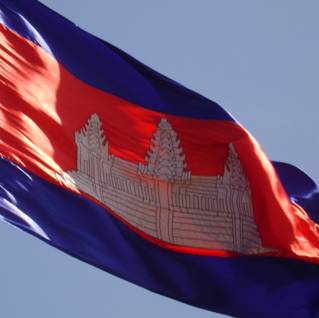
New bicycle!
Bicycles are the most common form of transport in Cambodia and yet there aren’t enough of them. When the photo above was taken, in late 2005, the boy had been the victim of a cycle theft; a first at Savong’s School. The thief had waited until class was in, and then helped himself to one of the many parked bicycles. The victim was distraught and it was not a good event for the brand new school’s reputation. We made good by promptly replacing the boy’s bicycle with a new one – and we placed the students’ bicycles under guard from then on. None have gone missing since.
But bicycle thefts are common in Cambodia, a signifier of the poverty that still plagues the country, as well as the thirst, especially, for new generation mountain bikes with their virtually puncture-proof tyres and sophisticated Shimano gears. One Facebook friend of mine lost his within 60 seconds after stopping at a roadside stall. He turned around and his Giant bicycle was gone.
As anyone who has ridden one knows, bicycles represent freedom. You can sail a bicycle further than you can comfortably walk, and it is the provision of bicycles that makes the difference for children in poor, remote areas between attending school and missing out school completely.
Not surprisingly then, a large number of charitable organisations are dedicated to providing bicycles for disadvantaged Cambodian children.These include:
Readers are invited to add others – there are many such initiatives.
The irony is, while we collectively buy new bikes, or gather and recondition used bikes from the west, and send these by container to Cambodia, the Kingdom is probably flooding your market and mine with bicycles made, actually, in Cambodia.
Cambodia is one of the five biggest bicycle exporters
These Cambodian made bicycles are selling fast in Europe where sales have climbed from 200,000 units per annum to more than 600,000 units (estimated) in just three short years. Cambodia is now the second biggest exporter of cycles into Europe now, behind only Taiwan.
Today, several Taiwanese-owned bicycle manufacturers are operating in Cambodia. They include Atlantic Cycle and its subsidiary A&J, who have operated in Cambodia since 2006, as well as relative newcomers Smart Tech (Cambodia) and Worldtec Cycles (Cambodia). The manufacturers are located in Svay Rieng province, near the Vietnamese border enabling components to be imported from Vietnam, and finished product ready for export across the border.
More recently the well regarded manufacturer of Specialized bicycles has also begun assembly in Cambodia.
To put things into perspective, here is the league table of global bicycle exports, as tracked by Daniel Workman, the founder of World’s Top Exports (WTEx) website: a great analysis of world trade patterns. Below are the 15 countries that exported the highest dollar value worth of bicycles during 2013:
- China: $3,189,787,000 (34.1% of total bicycle exports)
- Taiwan: $1,749,182,000 (18.7%)
- Netherlands: $669,720,000 (7.2%)
- Germany: $560,742,000 (6.0%)
- Cambodia: $437,076,000 (4.7%)
- Belgium: $275,488,000 (2.9%)
- Italy: $254,054,000 (2.7%)
- Spain: $185,760,000 (2.0%)
- Portugal: $173,618,000 (1.9%)
- Indonesia: $140,457,000 (1.5%)
- France: $139,044,000 (1.5%)
- Hungary: $137,902,000 (1.5%)
- United States: $125,300,000 (1.3%)
- Czech Republic: $118,654,000 (1.3%)
- Bulgaria: $115,392,000 (1.2%)
That was 2013, and exports have jumped since then.

Three reasons why Cambodia is the hot nation for bicycles
Why all this action? The answer is based on three things: cheap labour, anti-dumping moves against Chinese and Vietnamese manufacturers, and zero-tariffs for Cambodian sourced bikes into EU.
It is most probably the anti-dumping sentiment in Europe that kick started the growth of Cambodian cycle manufacturing. In Europe there was a concerted response to Chinese and Vietnamese made bikes that were flooding the market and threatening to damage, if not destroy the local bicycle manufacturing industry. Some manufacturers got round this by simply moving. their assembly factories from Vietnam to Cambodia
Besides labour costs in Cambodia are significantly lower than in neighbouring Vietnam and Thailand, which has also seen an out-migration of cycle manufacturing. With factory workers earning little more than $US65.00 for a 6 day week of full-time work, and the promise of fast-track approval by Government to remove any business red-tape, Cambodia has become attractive as an assembly point for bicycle manufacturers.
But here’s the clincher. Where bicycles from China or Taiwan or Thailand attract a 14% tariff in the lucrative EU market, Cambodian bicycles attract zero tariff.
The zero tariff goes back to an UNCTAD (United Nations Conference for Trade And Development) initiative, adopted by the EU, to encourage economic development amongst the world’s poorest nations (the so-called GSP List) by cutting tariffs.
According to the website of UNCTAD the scheme helps foster growth and job creation in developing countries. But according to the UNCTAD website the brakes may be coming on. Europe is likely to apply “cumulation” criteria to all bicycle imports. Put simply, if the parts are made in wealthier countries, and all Cambodia does is assemble these into bicycles, then the free tariff ride may be over.
Will the local cycle industry be big enough and resilient enough if this happens? And will the factory workers – whose conditions have been overshadowed by the garment workers case – get more than a living wage?
And does it make any sense to export bikes to a country that accounts for 5% of global cycle exports?
The answers, as usual in this complicated country, are not simple. The outcomes seldom fair.








You must be logged in to post a comment.